CBD Study In Horses Paves Way for New Research

Alicia Yocom, a veterinary resident in equine sports medicine at Colorado State University (CSU), in Fort Collins, teamed up with colleagues at CSU’s Veterinary Teaching Hospital to study CBD’s absorption within the horse’s body (its pharmacokinetics) while gathering data pertaining to safety. She shared those findings during the 2021 American Association of Equine Practitioners Conference, held Dec. 4-8 in Nashville, Tennessee.
During the study, 12 healthy mixed-breed mares were assigned to either a low- or high-dose group: The low-dose horses received 1 milligram per kilogram of body weight, while the high-dose horses received 3 milligrams per kilogram of body weight each day for six weeks. Yocom noted these were higher doses than various CBD supplement manufacturers commonly recommend.
On the first day all mares received their full dose in one serving. Then the research team took blood samples at eight time points within the first 24 hours to measure CBD levels. They also collected synovial fluid from the carpus (knee) and tested it for CBD at 12 and 24 hours after initial dosing. For the remaining six weeks of the study, the dose was divided into two feedings given 30 minutes after the mares were fed a pound of concentrated feed. The reason for giving the CBD following this meal, Yocom explained, is that results from one human study showed CBD was more bioavailable following a high-fat meal. The mares also received a standard 2% of their body weight in hay each day.
The researchers monitored the horses daily for changes in attitude, appetite, and manure production. Every two weeks they conducted physical exams and drew blood, looking for any changes in health, white blood cell count, and blood chemistry parameters, including liver enzymes. They also recorded CBD levels in blood plasma at two and four weeks and collected synovial fluid again at five weeks.
To conclude the study following the last dose, the team again took blood samples eight times within a 24-hour period. Blood samples were repeated 24, 48, and 96 hours after the last dose to determine how long CBD remains in the body after six weeks of cumulative dosing. The researchers took a final blood sample 10 days after the trial ended to evaluate blood chemistry parameters.
Yocom said she and her colleagues confirmed that CBD is bioavailable to horses when given orally. Physical exams and daily observations also detected no visible ill effects—nor any notable behavioral changes—in mares from either group. However, blood chemistry revealed that eight of the 12 horses experienced elevated liver enzymes, which returned to normal during, or soon after, the study ended, for reasons yet unknown. Another puzzle was a significant drop in blood calcium (known as hypocalcemia) in all 12 mares, although “ionized calcium” (the calcium in the blood that is not bound to protein, also known as free calcium) remained within normal limits. The change in calcium did not pose an imminent health danger, she observed, and the level returned to normal when the CBD supplement was discontinued.
Yocom shared several additional insights her team gleaned from the study:
- CBD plasma concentrations tend to peak four to five hours after feeding; therapeutic use might be timed accordingly.
- The recommended dosing interval is every 12 hours.
- CBD can remain in the horse’s system for 24 hours or longer (detectable in some study horses 96 hours after the last dose given).
- CBD was consistently detectable in synovial fluid at five weeks when provided at 3 mg/kg, but not at 1 mg/kg, suggesting a cumulative and dose-dependent effect.
- CBD levels in equine plasma tended to be low compared to those measured in dogs and humans after similar dosing periods.
Based on this new understanding of how horses metabolize and tolerate cannabidiol, said Yocum, researchers will focus future work on whether CBD delivers on its therapeutic promises.
Written by:
Betsy Lynch
Related Articles
Stay on top of the most recent Horse Health news with











